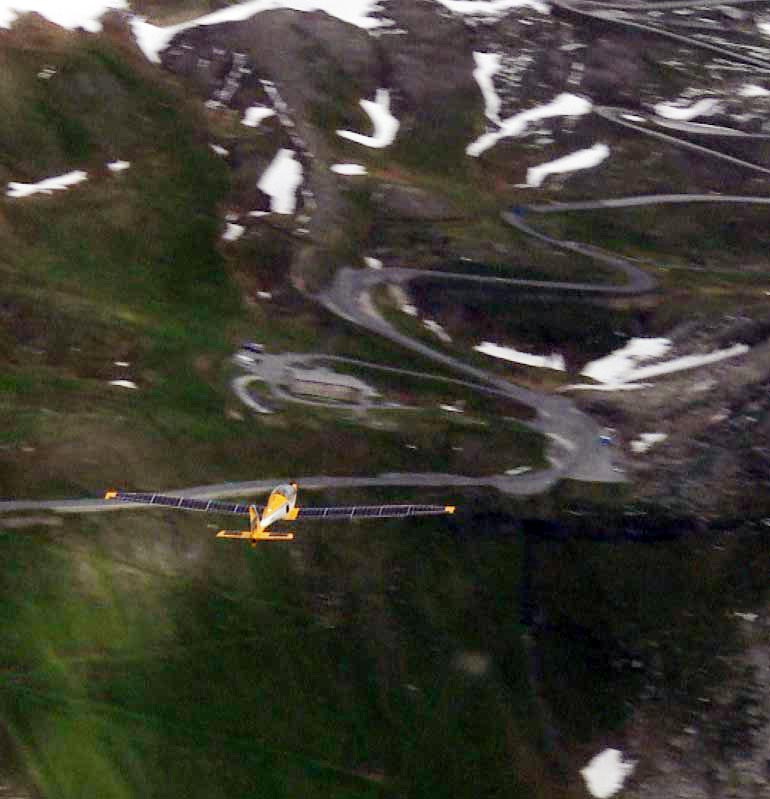
Elektra One Solar: Alps Crossing Under 18 kWh Energy

copyright 2015 Arno Trümper
Elektra One Solar from PC-Aero GmbH (Germany) started in Unterwössen (Germany) on 25 june for the Alps crossing over the Grossglockner and landed in the sunny town of Lienz in East Tyrol (Austria). The flight took around 2.5 hours. After the successful flight on the south side of the Alps, Elektra One Solar started on the way back on 2 july (few days before the e- Genius of the University of Stuttgart also flew over the alps) in quite difficult weather conditions. Despite headwinds and strong gusts the plane crossed the Alps at an altitude of more than 3000 m and landed after about 2 hours and 190 kilometers flight as planned at the airfield in Zell am See (Austria).
The emission and noise free flight was possible using 280 solar cells applied on the wing surface of the ultralight airplane and a 11.5 kWh battery package. The series production solar cells from the Solar World company in Germany provided about 30% of the needed energy. The maximum actual range of the aircraft is about 500 km.
On Bord: 3D-camera
A special high resolution camera for 3D landscape mapping (up to 5 cm resolution) was installed on board. The system was developed by the partner company Elektra UAS GmbH.
„We need not reinvent the aircraft for a clean mobility, we need only integrate and optimize existing technologies”, says Calin Gologan, the CEO of PC-Aero GmbH and Elektra UAS GmbH.
Rarely were so many future technologies integrated in a single product like the Elektra One Solar:
Light weight structures
High efficient electric engines and controls
modern Li-Ion batteries
Solarsystems
3D Camera
Autonomous flight
Elektra One Solar Datasheet:
Max. weight 300 kg
Empty weight (without Batteries) 120 kg
Battery weight 60 kg
Max. payload 100 kg
Wing span 13 m
Wing surface 10 m2
Continuous engine power 16 kW
Max. range up to 500 km
Max. endurance over 5 hours
Cruising speed 100 km/h
Wing aspect ratio 16.9
Best glide ratio over 30
Certification Ultralight Class Germany
(LTF-UL)
About PC-Aero GmbH
PC-Aero GmbH is a design, prototyping and certification office. Since about 5 years the company entered in the electric-solar aircraft business. Five Elektra One electric-/solar aircrafts were built in different versions from 8.6 m to 15 m wing span. The German ultralight certification will be finished up to the end of this year. The design of the two seat side by side version, Elektra Two trainer , was finished and the building of the prototype will be started this year. A license contract was signed with an US partner (aircraft name – Sun Flyer). The two seat tandem version, Elektra Two Record, was designed for high altitude stratospheric record flights up to 24 km. One prototype was just ordered by the Swiss company SolarXplorer. The prototype building was started and the first flight will take place in the first part of next year.
About Elektra UAS GmbH
About PC-Aero GmbH Elektra UAS is responsible for the unmanned (also Optional Pilot) applications of the aircraft platforms designed by PC-Aero. The applications includes 3D landscape/city mapping and communications like internet and mobile phone.
Kontakt:
Dr. Birgit Weißenbach
PC-Aero GmbH & Elektra UAS GmbH
Buchenweg 3
87484 Nesselwang / Germany
Telefon (0176) 23 41 14 91
birgit.weissenbach@pc-aero.de
www.pc-aero.de









![[Figure 1] Schematic of next-generation CNT-PANI composite fiber supercapacitor and comparison graph with recent results](https://www.innovations-report.com/wp-content/uploads/2025/05/KIST_leads_next-generation_energy_storage_technolo_1746783279-e1746784635527-362x245.jpg)


